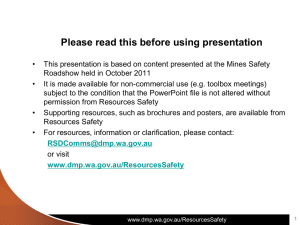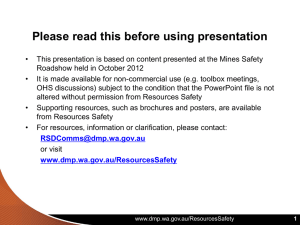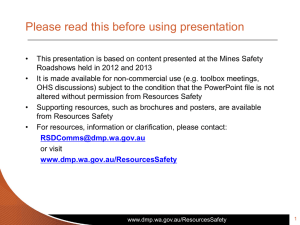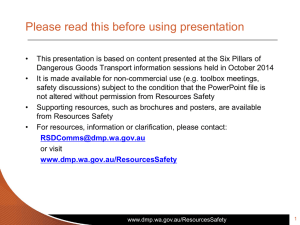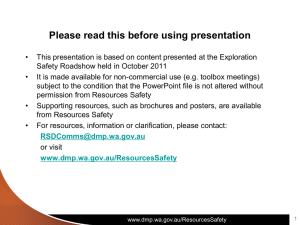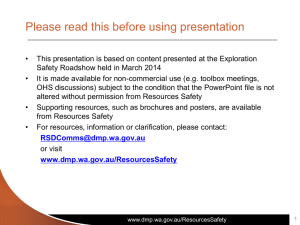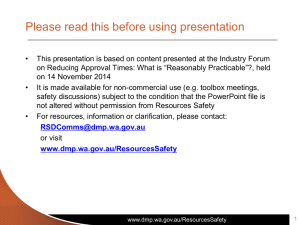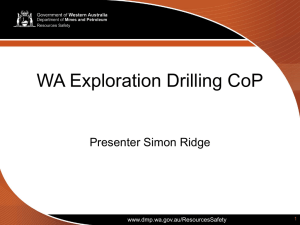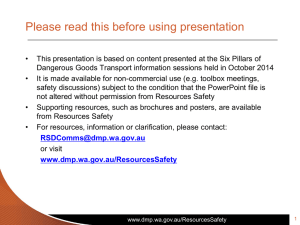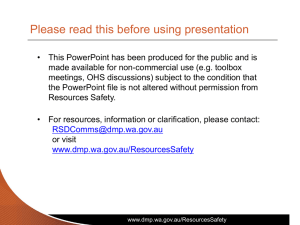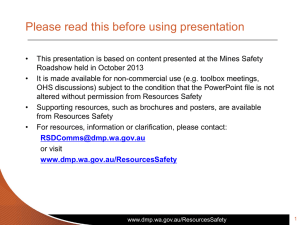Anagram approach to site incident investigations
advertisement
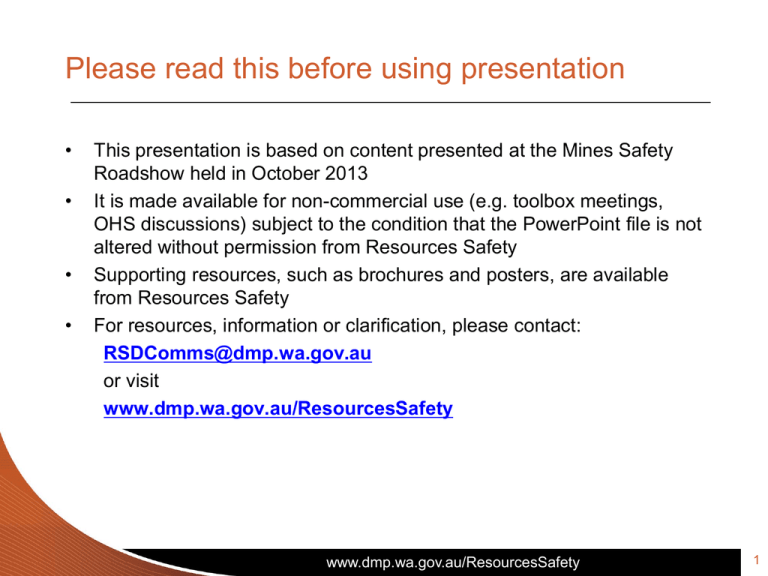
Please read this before using presentation • • • • This presentation is based on content presented at the Mines Safety Roadshow held in October 2013 It is made available for non-commercial use (e.g. toolbox meetings, OHS discussions) subject to the condition that the PowerPoint file is not altered without permission from Resources Safety Supporting resources, such as brochures and posters, are available from Resources Safety For resources, information or clarification, please contact: RSDComms@dmp.wa.gov.au or visit www.dmp.wa.gov.au/ResourcesSafety www.dmp.wa.gov.au/ResourcesSafety 1 Anagram approach to site incident investigations Can you move from “who” to “what” and “why” to “how”? www.dmp.wa.gov.au/ResourcesSafety 2 What should an investigation achieve? Gather information needed to identify trends and problem areas, permit comparisons and satisfy legal requirements Identify basic causes (direct and indirect) that contributed to incident Identify deficiencies in management system that permitted incident to occur Suggest specific corrective action alternatives for management system www.dmp.wa.gov.au/ResourcesSafety 3 What is the objective of the Act? Mines Safety and Inspection Act 1994 aims to: • Promote and secure the safety and health of persons • Assist employers and employees to identify and reduce hazards • Protect employees against risks associated with mining operations www.dmp.wa.gov.au/ResourcesSafety 4 Safety culture spectrum Vulnerable In denial Rule followers Deal ‘by the book’ Messengers “shot” Messengers ‘shot’ Conform to rules Whistleblowers dismissed or discredited Target = ‘zero’ Reactive Whistleblowers Repair not reform dismissed or Protection of the Information neglected powerful discredited Responsibility Information hoarded Responsibility shirked compartmentalised New ideas = ‘problems’ Repair not reform Failure punished or covered up Robust Develop risk management capacity Enlightened Active leadership Enhance systems Safety management plan widely known Improve suite of performance measures Competent people with experience Develop action plans Accountabilities understood Monitor and review progress Clarify/refine objectives Advanced performance measures Regular reviews Range of emergency responses catered for New ideas crushed Resilient Strive for resilience of systems rather Reform Reform rather than than repair repair Responsibility shared Actively seek new ideas Proactive as Messengers rewarded well asas Proactive well as reactive reactive Failures prompt farreaching inquiries Failures prompt Flexibility of operation Consistent mindset is far-reaching ‘wariness’ inquiries ‘in disarray’ pathological ‘organised’ reactive Sanction Direct ‘credible’ calculative ‘trusting’ proactive Encourage Partner www.dmp.wa.gov.au/ResourcesSafety ‘disciplined’ generative Champion 5 Resilient safety culture Safety is not the absence of accidents It is the presence of capacity and defences How does your site investigate incidents? What happens with that information? www.dmp.wa.gov.au/ResourcesSafety 6 What is the difference in how we see events? Old view New view (reform) Human error is a cause of accidents Human error is a symptom of trouble deeper inside a system To explain failure, investigations must seek failures of parts of systems To explain failure, do not try to find out where people went wrong These investigations must find inaccurate assessments and bad decisions Instead, find out HOW people’s actions and assessments made sense at the time, given the circumstances that surrounded them www.dmp.wa.gov.au/ResourcesSafety 7 Changing who and why W H O? AT WHY ? www.dmp.wa.gov.au/ResourcesSafety 8 James Reason’s ‘Swiss cheese model’ Reason’s Swiss cheese model www.dmp.wa.gov.au/ResourcesSafety Workshop WHAT happened here and HOW? Focus on the safety systems that failed and HOW that could have happened (contributory factors) Source: http://www.youtube.com/watch?v=hfh2yObrOHw www.dmp.wa.gov.au/ResourcesSafety 10 Take-away messages • Look beyond formal investigations and adopt this approach in the workplace setting when planning jobs • Ask WHO is doing what task and WHY before starting the job • Near-miss events are opportunities to maximise the benefits from asking WHAT and HOW during an investigation www.dmp.wa.gov.au/ResourcesSafety
